29.06 till 23.07.07, 24 days, currency rate 1 € = 9.5 N (Namibian dollar)
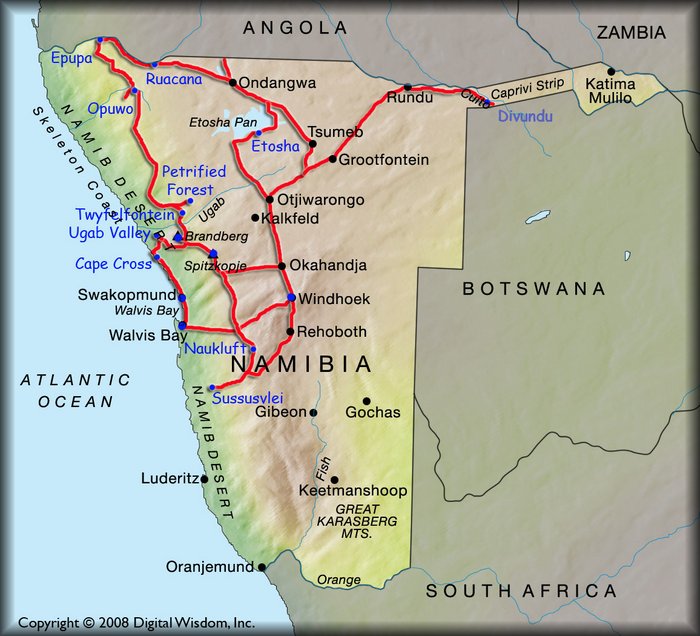
 highlights - crossing the border from Angola to Namibia was like get to another world - as soon as I got the passport stamp whole African spontaneity disappeared, which I get used to for the last half a year. I looked around - everything is where should be, there are supermarkets, ATMs, the pedestrian crossings, rubbish bins etc, like in Europe. Here we took a hot shower, the first time from Ghana, the second from Morocco.
highlights - crossing the border from Angola to Namibia was like get to another world - as soon as I got the passport stamp whole African spontaneity disappeared, which I get used to for the last half a year. I looked around - everything is where should be, there are supermarkets, ATMs, the pedestrian crossings, rubbish bins etc, like in Europe. Here we took a hot shower, the first time from Ghana, the second from Morocco.
Fast hitchhiking to lovely Windhoek, where we met the Magda for further travel. We hired car and at least we visited Namibia easily and conveniently.
 Unfortunately the disadvantage in visiting Namibia is strange organization of their national parks, where in high season (what happened), you must book in advance accommodation on campsites providing the exact date and number of people. Namib Desert and Etosha NP In have no more places in 2 weeks ahead. The worst, however, NP doesn't have a proper tourist information, there is no possibility to get basic simple maps, get any tips on where, when and how to watch wildlife. If you do not have the experience that is your bad luck. Other smaller parks and attractions have a similar lack of knowledge and maps. Often, the guide is mandatory, that is you are limited in time, you will go as your guide goes. In some cases, however, they have a lot of knowledge.
Unfortunately the disadvantage in visiting Namibia is strange organization of their national parks, where in high season (what happened), you must book in advance accommodation on campsites providing the exact date and number of people. Namib Desert and Etosha NP In have no more places in 2 weeks ahead. The worst, however, NP doesn't have a proper tourist information, there is no possibility to get basic simple maps, get any tips on where, when and how to watch wildlife. If you do not have the experience that is your bad luck. Other smaller parks and attractions have a similar lack of knowledge and maps. Often, the guide is mandatory, that is you are limited in time, you will go as your guide goes. In some cases, however, they have a lot of knowledge.
The country has fell us on the knees - so wonderful and picturesque landscapes. Driving in those unpaved empty roads all the time we were surprised with the landscape, and passing so few other cars we had the impression that the scenery is just only for us. We saw region Spitzkoppe and Brandberg, where canyons, arches and rock formations reminded me Arizona and Utah, freely running ostriches and strong wind Patagonia, a vast uninhabited space with the red ground, was a kind of Australia.
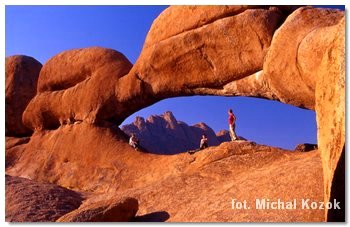 In Spitzkoppe I strongly recommend 10 minutes climb to the Bushman Paradise, to see the massive, curiously formed giant rock. Natural bridge is another attraction, where is a nice arc rock (nice picture with the mountains in the background in the arc window). You can also climb to the summit of Spitzkoppe (1728m), but the basics skills of climbing and good form is required.
In Spitzkoppe I strongly recommend 10 minutes climb to the Bushman Paradise, to see the massive, curiously formed giant rock. Natural bridge is another attraction, where is a nice arc rock (nice picture with the mountains in the background in the arc window). You can also climb to the summit of Spitzkoppe (1728m), but the basics skills of climbing and good form is required.
In Brandberg we went for a walk in Tsisab Ravine (2.5 km one way) to see the rock paintings, including the famous White Lady. This entry is allowed only with a guide with briefly explain. Coming towards the coast we saw the Ugab Valley, after passing rock formations "taken from Arizona". Unfortunately, the narrower roads are not designed for small, low-clearance overloaded 2WD vehicles. 10 km before Rihno Camp Site the road is suitable for 4-wheel-drive only. We got a flat tire, but we realized it too late and wheel have already been destroyed, so our expense grew up for the purchase of new wheel. By the main road we get into National West Coast Recreational Area.
 On the ocean was nice in Cape Cross Seal Reserve - open for viewing from 10 to 17. Among the less pleasant smell, hundreds of seals were seating around us on the rocks and sand, roaring, playing, and funny looked when the entire group was running to the water, there to give the show - jumping and the art of swimming. Tourists are walking behind the low walls on wooden path, which gives the possibility of close observation without disturbance of animals.
On the ocean was nice in Cape Cross Seal Reserve - open for viewing from 10 to 17. Among the less pleasant smell, hundreds of seals were seating around us on the rocks and sand, roaring, playing, and funny looked when the entire group was running to the water, there to give the show - jumping and the art of swimming. Tourists are walking behind the low walls on wooden path, which gives the possibility of close observation without disturbance of animals.
We were driving along the Atlantic a few hundred kilometres. After viewing Swakopmund, post German cosy town on the way to Walvis Bay, we find out another miracle of nature - the desert get into the water. This wild encounter of two "elements" seemed an ideal place for us, because Ewelina love the ocean, and my passion is the desert. However, the most beautiful views of the desert and the ocean (with numerous wracks vessels) can be found on the Skeleton Coast and south of Walvis Bay, beyond the reach of 2 WD car. We drove 6 km of Walvis Bay to salt ponds (lagoon) to watch flamingos - but didn't make a greater impression on us, they simply were too far away. Another attraction is the northern part of Namib-Naukluft Park with Welwitschia Drive, where you can see this incredible wilderness plant. We bought a cardboard on which we slide from the high dunes (we chosen Dune 7, the direction to the airport), but we missed the wax and ride wasn't fast enough. After sunset from the top of sand dunes, we get back to the capital to answer late colleague.
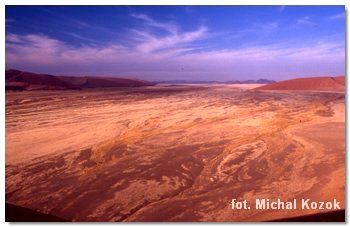 The next step was get to Sussusvlei, far away into wilderness. We decided to take a walking exploration of Namib Desert, one of the driest place on earth. From the park boundary is still 65 km to Sussavalei and without 4WD you must park 5 km earlier. We walked up to "Dead Valley" which enthused us. "Dead Valley" is an extraordinary, incredible composition of white dry ground cracks with black trunks of trees. This valley contrasts with the surrounding orange dunes with the blue sky background. I climbed to the top of the dune and the view was worth the effort, especially that I was lucky to encounter snake. Namib Desert sand dunes are huge, beautiful, red, almost free of vegetation.
The next step was get to Sussusvlei, far away into wilderness. We decided to take a walking exploration of Namib Desert, one of the driest place on earth. From the park boundary is still 65 km to Sussavalei and without 4WD you must park 5 km earlier. We walked up to "Dead Valley" which enthused us. "Dead Valley" is an extraordinary, incredible composition of white dry ground cracks with black trunks of trees. This valley contrasts with the surrounding orange dunes with the blue sky background. I climbed to the top of the dune and the view was worth the effort, especially that I was lucky to encounter snake. Namib Desert sand dunes are huge, beautiful, red, almost free of vegetation.
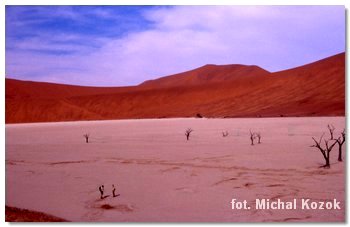 Wind is shifting sand every day and creates a unique system of irregular dune shapes. They are among the oldest and highest sand dunes in the world (325 meters). I decided to go back to the parking with loop route with the help of the compass, so I started lonely walk directly from the Dead Vlei to Hidden Vlei. A trek on sandy hills took me 5 hours, with numerous interruptions for photography. We also stopped at Dune 45, where you may climb to the 150-meter sand dune. View from the top on the entire valley to the east and the endless dunes to the south are impressive. We had no accommodation booking so we had to leave the park before sunset (for the same reason we missed the sunrise the next day). Although there was plenty of space for tents in camping, but was not allowed to use it without booking in advance?!
Wind is shifting sand every day and creates a unique system of irregular dune shapes. They are among the oldest and highest sand dunes in the world (325 meters). I decided to go back to the parking with loop route with the help of the compass, so I started lonely walk directly from the Dead Vlei to Hidden Vlei. A trek on sandy hills took me 5 hours, with numerous interruptions for photography. We also stopped at Dune 45, where you may climb to the 150-meter sand dune. View from the top on the entire valley to the east and the endless dunes to the south are impressive. We had no accommodation booking so we had to leave the park before sunset (for the same reason we missed the sunrise the next day). Although there was plenty of space for tents in camping, but was not allowed to use it without booking in advance?!
We spent a great time in nearby Naukluft Mountains, where 17 km Waterkloof Trail (7 hours including lunch break) provided the best views in gorges and on the tops, the possibility of watching wild baboons (with a bit of luck the mountain zebra), and bathing in colour pools. There is also 10 km Olive Track and, besides, 4 or 8-days organized tour (the latter only with a guide, take place between March and October).
We witnessed prehistoric times in Petrified Forrest (near Khorixas, Damaraland), the 260 million old years (however, has no standing trees, just pieces of lying trunks). Entrance with a guide, although the walk is just 500m. But after 20 minutes walk we asked our guide to go back for some photos, so a little time we spent without supervision.
In Twyflontein we looked rock drawings by San people. This is one of the three main sites in Southern Africa in terms of the importance of this rock art. There are two routes: 30 minute and hour. If you want to see both, you pay twice. We chose the longer one, fortunately this time the compulsory guide was able to transfer interesting knowledge, but also traditionally let us known then the tip is welcome. Not far are "The Pipes", but these rock formations did not get us a greater impression.
 Own vehicle gave us the opportunity to camp in wild, easy food carriage and its preparation on the stove or fireplace, which financially compensate the cost of car. In Damaraland region we met wild giraffes and elephants. During the camp we were listening if some elephant is not coming to our tents with its massive body. With the local population we kept contact mainly through giving them a lift. Incredible feeling was also observed the sandstorm on the horizon, following us in quick pace. Finally the storm got us - it was a wonderful demonstration of the forces of nature.
Own vehicle gave us the opportunity to camp in wild, easy food carriage and its preparation on the stove or fireplace, which financially compensate the cost of car. In Damaraland region we met wild giraffes and elephants. During the camp we were listening if some elephant is not coming to our tents with its massive body. With the local population we kept contact mainly through giving them a lift. Incredible feeling was also observed the sandstorm on the horizon, following us in quick pace. Finally the storm got us - it was a wonderful demonstration of the forces of nature.
 From all encountered tribes in Africa the greatest impression on us made Himba tribe, live in Namibian northern region known as the Kaokoveld. Himba covers the whole body by red-brown ochre, which above the attractiveness value also protects them from the sunburn and mosquitoes. They are very tall, slim people, smiling, wear the original jewellery, hair cover by clay and women with nice breast (as for Africa), are simply beautiful. We visited two villages - one for ourselves, and to the next one we took the local guide. However, this trip does not have anything to do with a "living museum" - here we are guests in their true and natural environment, in their village during daily common life, because the visit has not been arranged. It is important to select the proper operator, which does not always run to the same village. You can also suggest him the direction you want to go. Therefore, I recommend a guide KK from the yellow house in central Opuwo, next to petrol station (Kaoko Information Centre).
Himba tolerate tourists if you are not coming during traditional ceremonies. I was impressed by their easy going style, originality and strong ties with the tradition and resistance for the impact of civilization in their tribal structure. Even in urban supermarket we can find many Himba women - proud, barefoot, covered in a goat skin with naked tits, discussing about plastic products "made in China". Herero tribe is complete opposite - big, dressed in long Victorian dresses ladies, with a characteristic lateral scroll material on their forehead. Herero and Himba was once the same tribe, but the missionaries converted them to Christianity and changed their lifestyle (which you can see, mainly clothes and posture) - that did not match to African reality.
From all encountered tribes in Africa the greatest impression on us made Himba tribe, live in Namibian northern region known as the Kaokoveld. Himba covers the whole body by red-brown ochre, which above the attractiveness value also protects them from the sunburn and mosquitoes. They are very tall, slim people, smiling, wear the original jewellery, hair cover by clay and women with nice breast (as for Africa), are simply beautiful. We visited two villages - one for ourselves, and to the next one we took the local guide. However, this trip does not have anything to do with a "living museum" - here we are guests in their true and natural environment, in their village during daily common life, because the visit has not been arranged. It is important to select the proper operator, which does not always run to the same village. You can also suggest him the direction you want to go. Therefore, I recommend a guide KK from the yellow house in central Opuwo, next to petrol station (Kaoko Information Centre).
Himba tolerate tourists if you are not coming during traditional ceremonies. I was impressed by their easy going style, originality and strong ties with the tradition and resistance for the impact of civilization in their tribal structure. Even in urban supermarket we can find many Himba women - proud, barefoot, covered in a goat skin with naked tits, discussing about plastic products "made in China". Herero tribe is complete opposite - big, dressed in long Victorian dresses ladies, with a characteristic lateral scroll material on their forehead. Herero and Himba was once the same tribe, but the missionaries converted them to Christianity and changed their lifestyle (which you can see, mainly clothes and posture) - that did not match to African reality.
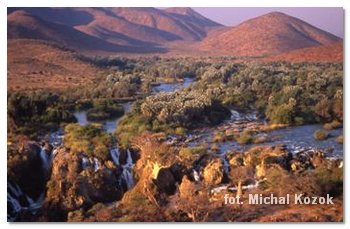 From Opuwo we drove in direction to the Angolan border, where Epupa Falls put us in the wonder condition, waterfalls with fabulous surrounding scenery. For a good lookout I recommend to go before sunset to the Sundown Hill, where the view is great. This is one of the few waterfalls which made an impression on me - but the fact, my expectations were zero, so nothing could disappointed me. You can walk around, there is a number of interesting trails. We traditionally slept on the wild, but there is a campsite next to waterfalls, N $ 50 per person. You can also swim in the water holes above the waterfall, but watch out, it would be stupid to let be swept by the river current.
From Opuwo we drove in direction to the Angolan border, where Epupa Falls put us in the wonder condition, waterfalls with fabulous surrounding scenery. For a good lookout I recommend to go before sunset to the Sundown Hill, where the view is great. This is one of the few waterfalls which made an impression on me - but the fact, my expectations were zero, so nothing could disappointed me. You can walk around, there is a number of interesting trails. We traditionally slept on the wild, but there is a campsite next to waterfalls, N $ 50 per person. You can also swim in the water holes above the waterfall, but watch out, it would be stupid to let be swept by the river current.
From here we travelled by interesting, sandy track to the east along the Angolan border. We picked up the kids returning from school. On one of the side rocky small tracks we gently broke the fuel tank. However, the fuel leaking was minimal, so on the way we still saw the Ruacana Falls. Free entry, but in the dry season I did not get a great impression. Surroundings concrete buildings are not the prettiest but the advantage is that you can step illegally into the Angolan side.
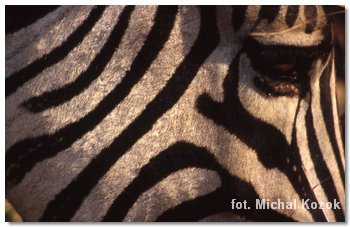 Finally we visited Etosha National Park, where just after the gates open at sunrise we were welcome by herd of zebras, antelopes gnu, impala, kudu and others. Not less warthogs, giraffes and elephants. Wildlife is used to cars, so you can actually watch them for long. However, in this park, you can not ride at night, get off from designated routes, or leave the vehicle. That obviously reduces the chance of tracking wildlife and photography them in full frame, as the Wildlife maintain in the safe distance. Information in the park practically does not exist, but worth to search in the visitor book with the tourist records - places or regions with time of the day which last animals have been seen. It might increase our chance for an interesting encounter. On the campsite there is a platform with light where tourists can watch the waterhole all night. need the patience to see the wild game (dry season increase the chance). We slept in Namutoni, but heard then Okaukuejo is even better, especially when it comes to rhinoceros (in any case, you can forgive the third camp - Halali).
Finally we visited Etosha National Park, where just after the gates open at sunrise we were welcome by herd of zebras, antelopes gnu, impala, kudu and others. Not less warthogs, giraffes and elephants. Wildlife is used to cars, so you can actually watch them for long. However, in this park, you can not ride at night, get off from designated routes, or leave the vehicle. That obviously reduces the chance of tracking wildlife and photography them in full frame, as the Wildlife maintain in the safe distance. Information in the park practically does not exist, but worth to search in the visitor book with the tourist records - places or regions with time of the day which last animals have been seen. It might increase our chance for an interesting encounter. On the campsite there is a platform with light where tourists can watch the waterhole all night. need the patience to see the wild game (dry season increase the chance). We slept in Namutoni, but heard then Okaukuejo is even better, especially when it comes to rhinoceros (in any case, you can forgive the third camp - Halali).
 I do not know how we did it, but we haven't seen any wild cats or rhinos. But generally for me the new flora and fauna what I have seen satisfied my expectations. There is worth to know the basic facts, which can make it easier to search the game: dawn and dusk are best time of animal activity, avoid the search in midday; increase you concentration during driving against the wind, they can't smell you; don't wear bright colours, green, brown and black colour will be the least noticeable for animals; in the dry season be more patience and wait longer next to the water source, is a bigger chance that eventually someone get thirsty; looks at the upper parts of trees, and under on the shaded places as well, there the predator may rest. The higher skills is
read the signs, but does not hurt to go in their direction. Do not forget binoculars, they are useful.
I do not know how we did it, but we haven't seen any wild cats or rhinos. But generally for me the new flora and fauna what I have seen satisfied my expectations. There is worth to know the basic facts, which can make it easier to search the game: dawn and dusk are best time of animal activity, avoid the search in midday; increase you concentration during driving against the wind, they can't smell you; don't wear bright colours, green, brown and black colour will be the least noticeable for animals; in the dry season be more patience and wait longer next to the water source, is a bigger chance that eventually someone get thirsty; looks at the upper parts of trees, and under on the shaded places as well, there the predator may rest. The higher skills is
read the signs, but does not hurt to go in their direction. Do not forget binoculars, they are useful.
Fee in the park is paid by the number of nights you spent here, but booking is essential well in advance during high season. We only could managed one accommodation booked in Windhoek (no others were available), so one night earlier and one later we slept in the wild just outside the park, once the north, once in south.
Namibia was definitely our most beautiful country in terms of African landscape.
| town | site | price in N | €/ pp | duration | note | comments |
| close Usakos | Spitzkoppe | 35 N/ person + 5 N/ car | €3.8 | 2 h | worth | |
| close Uis | Brandberg, White Lady | 25 N/ person | €2.6 | 1 h | Ok | guide included |
| Cape Cross | Seal Reserve | 40 N/ person + 10 N/ car | €4.5 | 1 h | worth | |
| Sesriem | Namib Desert NP | 80 N/ person + 10 N/ car | €8.7 | day | Super | |
| Naukluft NP | 40 N/ person + 10 N/ car | €4.5 | day | worth | ||
| close Khorixas | Twyfelfontein | 30 N/ person + 10 N/ car + 10 N/ 4person tip |
€3.7 | 1 h | Ok | guide included |
| close Khorixas | Petrified Forest | 25 N/ person + 10 N/ car | €2.9 | 30' | Ok | guide included |
| close Opuwo | Himba village own way |
74 N/ 4person | €1.9 | 30' | Super | food as a payment |
| Opuwo | Himba village, tour |
500 N/ group (3 person) | €17.5 | 3 h | Super | guide and food for Himba included, but you need your own car |
| Epupa Falls | Sundown Hill | 5 N/ person | €0.5 | 30' | worth | view on falls |
| Etosha NP | Etosha NP | 80 N/ person + 10 N/ car | €8.7 | 2 days | Super | |
| €59.3 |
![]()
 accommodation – shock for us as Africa has changed with level of service - from now on, hot shower, access to kitchen, internet, reliable information was in the majority of all the hostels. There usually offer a piece of lawn to set up your tent. Typically you pay per person, but in national parks you pay per occupied place and additionally per person.
accommodation – shock for us as Africa has changed with level of service - from now on, hot shower, access to kitchen, internet, reliable information was in the majority of all the hostels. There usually offer a piece of lawn to set up your tent. Typically you pay per person, but in national parks you pay per occupied place and additionally per person.
4-person room in Etosha NP cost 500 N$.
| town | hotel and address | N | accommodation | price per night | €/ pp | note | comments |
| Ondangwa | Church Guest House | 1 | tent | 10*N/ person | €1.1 | 7 | |
| Windhoek | Chameleon Backpackers and Guest House, LP |
6 | tent | 50 N/ person | €5.3 | 9 | Super |
Naukluft NP Camp, LP |
1 | tent | 30 N/ person + 10 N/ car | €3.4 | 6 | bookings in Windhouk |
|
| Opuwo | Kunene Village Rest Camp, LP |
1 | tent | 50 N/ person | €5.3 | 6 | |
| Etosha NP | camping Namutoni, LP |
1 | tent | 100 N/ place (4per) + 50 N/ person |
€7.9 | 6 | bookings in Windhouk |
| close Divundu | Ngepi Camp, LP | 2 | tent | 70 N/ person | €7.4 | 6 | |
| in wild | 11 | ||||||
| hospitality | 1 | tent | |||||
| 24 | €64.3 (12) |
![]()
 transport– I recommend the rental company in Windhouk odyssey@iway.na, where the cheapest car Toyota Tazz cost 390 N$ per day (over 10 days discount 10%). The deposit for the car is 9,300 N$, payable by credit card or cash. If you are interested in the 4WD car, however, during the European holidays may be problem without the earlier reservation. The entire route is described below as we drove with two-wheel-drive car, four people with luggages plus sometimes local hitchhiker. The clearance was not the best one, but we travelled the tracks officially accessible to the 4WD cars and the fuel tank we broke on the side walking path, when we tried to hide a car for the time of trekking. You need to be careful after the rain fall, otherwise can do the same route.
transport– I recommend the rental company in Windhouk odyssey@iway.na, where the cheapest car Toyota Tazz cost 390 N$ per day (over 10 days discount 10%). The deposit for the car is 9,300 N$, payable by credit card or cash. If you are interested in the 4WD car, however, during the European holidays may be problem without the earlier reservation. The entire route is described below as we drove with two-wheel-drive car, four people with luggages plus sometimes local hitchhiker. The clearance was not the best one, but we travelled the tracks officially accessible to the 4WD cars and the fuel tank we broke on the side walking path, when we tried to hide a car for the time of trekking. You need to be careful after the rain fall, otherwise can do the same route.
 The "km" data in the table are real, not read from the map, include all the detours, rides in the parks, driving in search of wild places for accommodation, etc.
The "km" data in the table are real, not read from the map, include all the detours, rides in the parks, driving in search of wild places for accommodation, etc.
hitchhiking works here sensational, but attention for the safety at evenings, especially near Windhoek and in the northern part of the country.
When entering Botswana from the Caprivi Strip in Divundu, you must cross the Mahango Game Reserve. Do not pay the admission fee if you do not stop in the park.
| day | destination | transport | price in N | €/ pp | duration | km |
| 170 | Oshikango - Ondangwa | 2x hitchhiking | - | - | 1 h | 63 |
| 171 | Ondangwa - Windhoek | 3x hitchhiking | - | - | 11 h | 674 |
| 175 | Windhoek - Spitzkoppe - Brandberg | rental car Toyota Tazz | 1170 N/car per 3 days in 4persons; fuel 584 N/1373km; new wheel 290N |
€54.4 | 3 days | 480 |
| 176 | Brandberg - Ugab Valley - coast | 250 | ||||
| 177 | Cape Cross - Swakopmund - Walvis Bay | 250 | ||||
| 177 - 178 | Walvis Bay - overnight back to Windhoek | 393 | ||||
| 180 | Windhoek - evening departure - close Sesriem | rental car Toyota Tazz | 3861 N/ car per 11 days in 4persons; fuel 1542 N/ 3245km; repairs 118 N |
€145.3 | 11 days | 350 |
| 181 | close Sesriem - Sussusvlei - close Sesriem | 150 | ||||
| 182 | close Sesriem - Naukluft NP | 120 | ||||
| 183 | Naukluft NP - close Twyfelfontein | 700 | ||||
| 184 | Twyfelfontein - Petrified Forest - close Opuwo | 450 | ||||
| 185 | around Opuwo (Himba) | 70 | ||||
| 186 | around Opuwo (Himba) - Epupa Falls | 220 | ||||
| 187 - 188 | Epupa Falls - along Kunene River - Ruacana Falls - north gate of Etosha NP |
500 | ||||
| 189 - 190 | Etosha NP in park and to south gate |
510 | ||||
| 191 | south gate Etosha NP - Otjiwarongo |
175 | ||||
| 191 | Otjiwarongo - Windhoek (friends taking the car to rental company) |
- | fuel 120 N/ 4persons | €3.2 | - | - |
| 191 | Otjiwarongo - Divundu | 2x hitchhiking | - | - | 6 h | 661 |
| 194 | Divundu - border | 2x hitchhiking | - | - | 30' | 20 |
| ticket for Ewelina Windhouk - Divundu | minibus, hitchhiking | 144 N/ person - in 3 per | €5.1 | - | - | |
| €208.0 | 6036 |
![]()
visa – majority of European citizens do not need visa, but the Poland is Poland. We still have hope this will change, or that at the end proposal one united visa for all southern African countries come true. We have received a visa in Luanda, 2 days waiting, entry during the month, stay up to 60 days, price 30 USD (22 €). Friend arranged a visa in Cape Town without any major problems.
In Namibia we can find embassies of following African countries: Angola, South Africa, Botswana, Kenya, Malawi, Zambia and Zimbabwe.